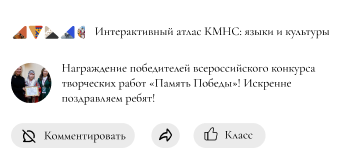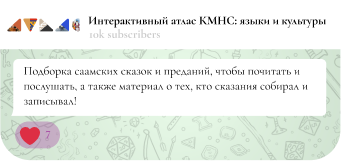Institute of Linguistic Studies, Russian Academy of Sciences
М. Pupynina
Alyutor
-
1. Sociolinguistic Data
Existing Alternative Names for the Language
In pre-Soviet times, the inhabitants of the shores of the Kamchatka isthmus were called Lyutors or Alyutors. There was a similarity between their language and that of Koryaks, sedentary inhabitants of the Penzhinskaya Bay and nomadic reindeer herders in the northern part of the Kamchatka peninsula.
In the 1930s, scholars suggested reuniting all these ethnic groups under the same ethnonym Nymylan
,
based on the self-designation of indigenous inhabitants of coastal villages of the Kamchatka isthmus (cf.
нымылъу
“villagers”). Thus, the notion of the Nymylan language was introduced as well. At the same time, the Koryak ethnonym continued to be used, and the language was still referred to as Koryak. S. Stebnitsky, a researcher of Koryak, distinguished 8 Nymylan (Koryak) dialects, some of which, including Alyutor, had peculiar features. In the post-war period, official documents referred to all the above-mentioned groups as Koryaks, and referred to all their languages and dialects as Koryak. They stopped using the Nymylan designation in both scholarly literature and official documents until the beginning of the 21
st
century. In the 1970s, following the expedition of Moscow linguists A. Kibrik, I. Muravieva, and S. Kodzasov, the Alyutor dialect of the Koryak language was rightfully recognized as a language in its own right. In 2000, the Alyutor ethnonym was included in the Consolidated List of Indigenous Small-Numbered Peoples of the Russian Federation, after which Alyutor officially became an indigenous language. This recognition of its independent status was based not only on its linguistic features but also on the social and political principles of tolerance toward the small-numbered subethnoi of the Russian Federation.
Linguists often use Alyutor as a modern name for the Alyturor dialect, as well as an umbrella term for the dialects of several local (semi-)sedentary groups, such as Alyutors, Rekinnikov, Palana, and Karagin. These groups inhabited the northern part of the Kamchatka peninsula on both western and eastern shores. Traditionally, Koryak Nymylans were not only marine fishermen and hunters, but also reindeer herders, which is why they were able to roam long distances.
Despite the active use of the Alytor designation by linguists, its native speakers do not accept this name, since they believe that it refers strictly to the dialect spoken by the population of Olyutorka (its original name was Alyut), a village that went extinct in 1975. Historically, it does
date back to the name of one of the Koryak Nymylan settlements. The nomadic Koryaks use the word
элутэлг’у
to describe the coastal population, Nymylans, which is probably why Russian pioneers associated the word Alyutor, derived from this word, with other inhabitants of coastal settlements. In the 20
th
century, it would have been more logical to use the self-designation
нымылъу
meaning “settlers” or “villagers” to name this subethnos. In Russian, it is pronounced Nymylans, which is exactly the way all representatives of this subethnos refer to themselves in Russian. Ironically, it was the term Alyutor that was used in the Consolidated list of indigenous small-numbered peoples of the Russian Federation (based on historical evidence of Russian pioneers and researchers), thus, the language was also named Alyutor. At the same time, all native speakers call it either Nymylan or Koryak, for they believe that Alyutor can only be applied to the dialect of Alyut people.
It should be noted that Yukari Nagayama named her dictionary for Koryak Nymylans
Нымыланско-русский словарь
(Nymylan-Russian Dictionary), which is consistent with the expectations of Alyutor speakers, but goes against the established linguistic terminology.
-
Nutayulgin highlighted that if Koryak Nymylans wished to say that somebody spoke their language, they used the word
нымыл
ь
ысъинаӈ
, which literally means “Nymylan.” It is
relevant to the lingual variants of all the above-mentioned Nymylan groups: Alyutor (residents of Olyutorka and neighboring villages), Karagin, Palana, and Rekinnikov. There are also special words for Karagin and Rekinninov dialects, such as
ӄараӈынниг’эӈак
[speak Karagin],
рыкыннюг’эӈак
.
-
2. General Characteristics
2.1. Total Number of Speakers and their Ethnic Group
The 2010 All-Russian Population Census does not mention the Alyutor ethnonym and only 25 people indicated that they considered their native language to be Alyutor. Its speakers identified themselves as Koryaks or Nymylans and considered their language to be Koryak or Nymylan. Yukari Nagayama, a Japanese field researcher, argued that in 2015 around 200 people spoke Alyutor and related dialects. They were all residents of the Kamchatka Territory. The youngest Alyutor speakers are approximately 50 years old. In October 2021, during the online transmission of the Dulzon Readings International Conference (September 15–16, 2021), audience members asked the Japanese linguist to estimate today’s number of Alyutor speakers. Yukari Nagayama answered that there were around 100 people since many older informants, native Alyutor speakers, died over the last 10 years. However, V. Nutayulgin, a native speaker and language activist, sees the situation more optimistically. Furthermore, this estimate most likely does not include people who simply understand the language. The level of such passive command of the language can vary greatly from understanding a very complex story to following simple instructions and indications in Alyutor. The latter can be observed even among young people and older children.
2.2. Threat of Extinction and Age of Native Speakers
Overall, the situation around the use of Alyutor is very similar to that of Koryak. All present-day Alyutor speakers are fluent in Russian. They use the indigenous language only occasionally, for Russian dominates
in most interactions. However, people aged over 50 claim that they went to school without speaking any Russian. Growing up, the representatives of the older and middle generation (1940s–1970s) heard only the indigenous language at home, but they all went to Russian boarding schools. There, the ethnic language was not only excluded from the curriculum, but even entirely forbidden, both in classrooms and extracurricular activities. In the 1950s-1970s, one of the priorities of Soviet education was to encourage indigenous children of the Far North to become completely fluent in Russian. This language policy was widely and forcefully implemented, often at the expense of the national language. Thus, for some of these children, the return to their native linguistic environment happened only after the Russian language had established its dominance in their communication.
The younger generation (i.e., born after 1980) consists mainly of passive users of the ethnic language, meaning that they do understand Alyutor but prefer to answer in Russian. It is not uncommon for one of the parents to speak Alyutor to his son or daughter in a Russian-speaking environment. At the same time, young people understand perfectly some Alyutor phrases and do not hesitate to respond, but they do not use Alyutor. Having no experience in active communication in the native language, the younger generation (most of them children of mixed marriages) prefers to speak only Russian. One might say that young people and some middle-aged adults tend to have a low esteem of their own language proficiency. At the same time, those representatives of middle and even young generation of Alyutor speakers who had language-related jobs (e.g., language teachers, journalists, and cultural workers,) managed to preserve their mother tongue. They are the ones who are currently helping specialists to decipher the recordings of older Koryak Nymylans from the 1990s and the beginning of the 21
st
century, prepare publications in Alyutor, organize staged versions of national festivals. In that way, they not only preserve the ethnic language in their memory, transmit it, but also constantly improve their own language proficiency while deciphering audio recordings. When they write the scripts of events, prepare articles or newscasts, they have to select native vocabulary consistent with the goals of a project. The capacity of Alyutor to incorporate new words allows to create a new vocabulary, since there is a need to write down the nonethnic realities, including those from the political life of the modern Russia. Therefore, despite the seemingly critical state of Alyutor, its development is ongoing.
2.3. Use in Various Spheres of Communication
Whenever there is a person who is capable and willing to teach Koryak at a nursery school, the local administration of preschool educational institutions does everything in its power to make it possible. We know that there are native language lessons in the nursery schools in Tymlat, Karagin district, and Palana, Tigil district. It is highly likely that this initiative is also supported in other towns and villages of the Koryak District. However, there are no educational and methodological materials in Alyutor since the language has no established system of writing. Sometimes, there are Alyutor language groups for adults and children. Local TV- and radio stations broadcast newscasts in Alyutor that are prepared and voiced by Vladimir Nutayulgin and Anna Bogoyavlenskaya.
In Kamchatka, there are folk dance companies encompassing the representatives of all indigenous ethnic groups of the peninsula: Itelmens, Koryaks (Chavchuvens), and Koryaks (Nymynlans or Alyutors), as well as Evens. Stage performances occasionally include songs or lines in Koryak and Alyutor. The Koritev, Mengo, and Uykav dance ensembles are particularly popular.
The oral tradition still contributes to the preservation of fairy tales and historical legends in Koryak and Alyutor. Based on the results of expeditionary studies, the Kamchatka Folk Art Center publishes an annual edition of folklore texts in Koryak and Alyutor. All editions are available online on the Center’s official website.
Alyutor is used during national rites and ceremonies. Video recordings of some rites in their modern interpretation are available on the website of the Kamchatka Folk Art Center.
Public attention to the loss of linguistic diversity worldwide has significantly improved the status of minority languages and thus encouraged the creative linguistic activities of native speakers of such languages, including Alyutor. Thus, in the 2010s-beginning of the 2020s, there was a rise in the popularity of staged national festivities at city and district levels, where the national language has always been present. There is an annual selection of best essays written in a native language in the Kamchatka Territory. The online portal of the Kamchatka Folk Art Center regularly features new videos of events, small stage productions, and Alyutor language courses. Furthermore, there are new Alyutor editions with online versions available on the Center’s website. These measures affect the vitality of the language, and we are now witnessing the expansion of a minority language. There are young people interested in learning the languages of their grandmothers and grandfathers, and even though their linguistic competence is far from advanced, there are clearly some elements of positive dynamics.
2.4. Dialects
At present, there remains only one dialect related to Alyutor called Palana. It looks like there are no more speakers of two other dialects associated with Alyutor called Rekinnikov and Karagin. It is possible that there are still some passive Karagin speakers left. Unfortunately, the Rekinnikov dialect remained virtually unrecorded, but there were publications of several texts in Karagin.






















































